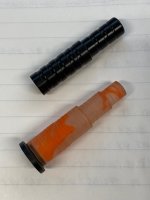From Wikipedia:
Polyoxymethylene (POM), also known as acetal,[4] polyacetal, and polyformaldehyde, is an engineering thermoplastic used in precision parts requiring high stiffness, low friction, and excellent dimensional stability. Short-chained POM (chain length between 8 and 100 repeating units) is also better known as paraformaldehyde (PFA). As with many other synthetic polymers, polyoxymethylenes are produced by different chemical firms with slightly different formulas and sold as Delrin, Kocetal, Ultraform, Celcon, Ramtal, Duracon, Kepital, Polypenco, Tenac and Hostaform.
POM is typically very difficult to bond, with the copolymer typically responding worse to conventional adhesives than the homopolymer.[24] Special processes and treatments have been developed to improve bonding. Typically these processes involve surface etching, flame treatment, using a specific primer/adhesive system, or mechanical abrasion.
Typical etching processes involve chromic acid at elevated temperatures. DuPont uses a patented process for treating acetal homopolymer called satinizing that creates a surface roughness sufficient for micromechanical interlocking. There are also processes involving oxygen plasma and corona discharge.[25][26] In order to get a high bond strength without specialized tools, treatments, or roughening, one can use Loctite 401 prism adhesive combined with Loctite 770 prism primer to get bond strengths of ~1700psi.[24]
Once the surface is prepared, a number of adhesives can be used for bonding. These include epoxies, polyurethanes, and cyanoacrylates. Epoxies have shown 150–1,050 psi (1,000–7,200 kPa)[24] shear strength. Cyanoacrylates are useful for bonding to metal, leather, rubber, cotton, and other plastics.
Solvent welding is typically unsuccessful on acetal polymers, due to the excellent solvent resistance of acetal.[citation needed]
Thermal welding through various methods has been used successfully on both homopolymer and copolymer.[27]

